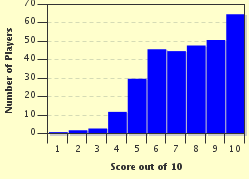Quiz Answer Key and Fun Facts
1. An artist who spent four weeks atop Billboard's Hot 100 chart in 1967 would only have one other Top 40 solo entry, a modest Number 31 hit three years later. What Southern Gothic narrative, which became that Number One hit, discusses events that unfolded on Choctaw Ridge and the Tallahatchie Bridge?
2. In 1967, The Doors scored a huge Number One hit with "Light My Fire" that was rated as the fourth biggest song of the year. A year later, a young Puerto Rican covered the song with a Latin-Soul motif and took it to Number Three on the Hot 100 and a Number 51 ranking for the entire year. He would have another reasonably big Number 25 hit later in the year with a cover of the Ramsey Lewis gem, "Hi-Heel Sneakers", but would never soar to those lofty Hot 100 heights ever again. Who was this two-hit wonder?
3. "To divide this cockeyed world in two
Throw your pride to one side, it's the least you can do
Beatniks and politics, nothing is new
A yardstick for lunatics, one point of view
Who cares what games we choose
Little to win but nothin' to lose"
The Strawberry Alarm Clock would have two Top 40 Billboard hits and these lines were plucked from their biggest hit, a Number One classic from 1967. What song was it?
4. There were rafts of bands in this era that specialized in that short lived genre of music known as psychedelic. Many only had one significant hit; the lucky ones managed two. The Electric Prunes were one of the latter and their biggest hit is represented with the following lines. What song was this?
"The room was empty as I staggered from my bed
I could not bear the image racing through my head
You were so real that I could feel your eagerness
And when you raised your lips for me to kiss
Then came the dawn and you were gone
You were gone, gone, gone"
5. Who remembers the two-hit wonder group Vanilla Fudge? More importantly, who remembers their big Number Six hit from 1968, a cover version of an earlier Supremes hit? This line should provide the clue you need!
"Set me free why doncha babe, get out of my life why doncha babe"
6. I can only name one predominantly black group that dabbled in the genre of psychedelic music in the late 1960s. That group was The Chambers Brothers and they meet the criteria for inclusion in this quiz with just two Top 40 hits. Their biggest hit began with the sound of a drumstick alternately striking a cowbell and a shut hi-hat cymbal. As the song evolved, the vocalist eventually sang these words with urgency. What song was it?
"I might get burned up by the sun
But I'll have my fun
I've been loved and put aside
I've been crushed by a tumbling tide
And my soul has been psychedelicized"
7. A singer/composer from this era named Joe South was perhaps better known in the latter capacity and for the songs he wrote for others. However, he recorded a couple of his own compositions and ironically, they both peaked at Number 12, one in 1969, the other a year later. Both were filled with astute observations about human behavior and it was a toss-up as to which song merited special attention via a lyrical sample. I chose the 1969 song which garnered a Grammy for Song of the Year and contained these words. Can you remember it?
"People walking up to you singing glory halleluiah
And they're tryin to sock it to you in the name of the Lord
They're gonna teach you how to meditate, read your horoscope, cheat your faith
And furthermore to hell with hate, come on and get on board"
8. "I was wrong, baby, I took too long
I got caught in the rush hour
A fellow started to shower
You with love and affection
Come on, look in my direction"
A group known as the Soul Survivors made a brief splash with a Number Four hit in 1967 and the lines above were culled from that release. Unfortunately, their next charting effort entitled "Explosion in Your Soul" was a minor hit stalling at Number 33 and the one after that finished at a dismal Number 68. Never again would the group impinge on Billboard's Hot 100. What was the title of the group's big debut hit?
9. From 1964 to 1969, an artist born and raised in Great Britain would have 12 top 40 hits in his homeland including three chart toppers. The story was different in America, however, and he would only breach the Billboard Top 40 with a Number 21 song in 1965 and a Number Seven hit in 1968. Georgie Fame was the name and a unique fusion of R&B and jazz was his game. His biggest Billboard hit dealt with the criminal element but due to the nature of the lyric, a hint of that nature is impossible... you'll either know it or you won't! Do you?
10. Another British band named The Foundations found themselves with two catchy Billboard Top 40 hits in the late 1960s before folding their tent in 1970. The first was the 1968 Number 11 song, "Baby, Now That I Found You". A year later, they had an even bigger Number Three hit that has remained quite popular ever since. I hope the following lines ring a bell as your lyrical clue.
"And then worst of all, you never call, baby,
When you say you will but I love you still
I need you more than anyone, darling
You know that I have from the start"
Source: Author
maddogrick16
This quiz was reviewed by FunTrivia editor
agony before going online.
Any errors found in FunTrivia content are routinely corrected through our feedback system.

